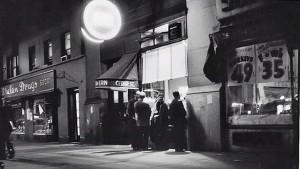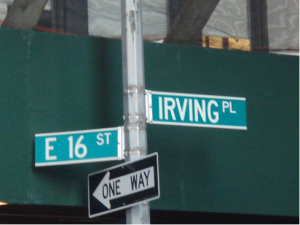The last remnants of the Cedar Tavern (always referred to as the Cedar Bar), 82 University Place in Manhattan’s Greenwich Village, are being demolished to make way for a waxing salon. Nostalgia can can cloud vision. But, not Lee Siegel’s vision. The writer has a very balanced account of Cedar Bar in a New York Times Op-Ed piece and comes to some surprising conclusions. Permit HG to review the Cedar Bar history. In the 1950’s and early 1960’s it was the hangout of the hard drinking, rambunctious New York school of abstract expressionists and other painters who became modernist icons — de Kooning, Rivers, Pollock, Kline, Guston, Motherwell, etc. Their presence attracted writers, film makers, poets, musicians and a motley crew of bohemians. It was a macho crew so there were plenty fisticuffs and alcohol fueled rage (and hilarity). Needless to say, misogynistic and homophobic language and behavior flowed free. Siegel points out that women were always treated badly. He quotes Lee Krasner, Jackson Pollock’s wife and an extraordinary painter in her own right: “I loathed Cedar Bar. Women were treated like cattle.” Gays were insulted and made uncomfortable. One saving grace of the Cedar was it was very inter-racial. It was a bar where HG always felt comfortable drinking with his African-American girl friends. (Yes, women were treated shabbily. But, not African-American women. The Cedar’s ferocious leftists saw to that.)
HG was a man of his time. HG loved the Cedar Bar and shared most of the nasty attitudes of its habitues. When HG lived in the Gramercy Park neighborhood (more than 50 years ago) HG had a Saturday routine. Little daughter Victoria (now the distinguished restaurateur — Five Points, Cookshop, Hundred Acres) was placed in her stroller and the duo was off on a stroll through 23rd Street (great bookshops), Gramercy Park (HG had a key for a short period), Irving Place (a grilled cheese sandwich for little Vicki at Pete’s Tavern), Washington Square Park and, as a final destination before returning home, Cedar Bar. Vicki was perched on the bar where she munched pretzels and peanuts and was admired by all for her remarkable blonde cuteness. As for HG, there were numerous martinis while HG participated in vigorous discussion. A very boozy and joyful afternoon indeed.

Manhattan’s Irving Place is a short street, occupying the six blocks between Gramercy Park and East 14th Street. It has a colorful history and, like many New York streets, has gone through many changes. Lots of memories for HG. Pete’s Tavern (corner of Irving Place and East 18th) was a favorite of HG’s. Wonderfully old fashioned bar and booths (owners claim it was founded in 1864 making it the oldest continually operating tavern in New York). Many an HG date started in a booth at Pete’s with the couple sipping the obligatory Martinis. Food was an afterthought but it was a perfectly acceptable place for a burger and a beer (however if you wanted a really delicious burger at an old fashioned bar, P.J. Clarke’s was the place). Pete’s had the reputation of being favored by literary types. Heavy drinking O.Henry (who lived nearby) made it his local and Ludwig Bemelmans sketched his first Madeleine tale on a Pete’s menu. According to HG’s informants, Pete’s decor remains virtually intact (you may have seen it on Seinfeld and Law & Order) but its clientele is mainly gawking tourists. Too bad.
For great dining on Irving Place knowing gourmands went to Paul and Jimmy’s Italian Restaurant. Paul and Jimmy Delgado (thus the name) opened the restaurant in 1950 and it had a great run for 18 years. The restaurant (under new ownership) moved from Irving Place to 123 E. 18th Street and is still in existence. HG has never been to the modern P & J so can’t vouch for the cuisine. But, the old Paul and Jimmy’s was pure delight (remains BSK’s favorite restaurant). It had all the traditional Italian delights — Mozarella in Carozza, Clams Oreganata, Clams Casino, Chicken Scarpariello, etc. Toothsome pastas. Paglia e Fiene (Hay and Straw) was always ordered by HG. This was a combination of thin spinach and egg pasta in a tomato cream sauce. Wonderful seafood including Whiting in Brodetto and a very unusual dish of striped bass poached in oil, vinegar and garlic. BSK recalls an very antic event at P & J’s: A rather large rat strolled in from the street. He sheltered under a table. Instead of panicking, the table of sophisticated New Yorkers made friends with the rodent and fed him various tidbits. A cook came rushing from the kitchen, cleaver in hand, with the intention of decapitating the rat. He was dissuaded. The rat, now full and happy, ambled back to the street and everyone in the restaurant (including HG and BSK) just kept on eating, drinking and laughing. Paul and Jimmy’s was that kind of happy place.
An interesting woman identified with Irving Place was Elsie de Wolfe (1865-1950), also known as Lady Mendl after her marriage in 1926 to Sir Charles Mendl. She lived in a town house on Irving Place with another interesting woman, Elizabeth Marbury. The Mendl-Marbury relationship (presumably lesbian) lasted some 40 years. Marbury was a pioneering theatrical agent with Oscar Wilde and George Bernard Shaw among her clients. Lady Mendl invented the profession of interior designer and revolutionized the way Americans furnished their homes with her book The House in Good Taste. Her revolutionary design style stemmed from the Mendl/ Marbury Irving Place town house. It was light and airy and filled with sunshine and her celebration of those qualities sounded the death knell for the heavy, fussy, super masculine decor of the Victorian era. The Mendl/ Marbury couple was prominent in New York society (the women were known as “the Bachelors”). When Society folks visited their town house, they fell in love with Lady Mendl’s interiors and her simple ability to (as she herself put it): “let the air and sunshine in.” At present there is a charming boutique hotel occupying two Irving Place town houses — The Inn at Irving Place. It contains the Lady Mendl Tea Salon. Lady Mendl would deplore the decor since it is resolutely Victorian. Ludwig Bemelmans (whom HG mentioned in connection with Pete’s) was a close friend of Lady Mendl and wrote a light-hearted memoir of her, “To The One I Love The Best.” HG particularly fancies Lady Mendl’s personal motto (embroidered on many pillows): “Never Complain, Never Explain.”
Irving Place also had a theatrical history. It was the site of the Irving Place Theater, a place which went through a multitude of changes. A young immigrant, Shmuel Goldfisch (later changed his name to Samuel Goldwyn) fell in love with theater when he saw ballet at the theater. He explained: “I went to the ballet because you didn’t have to understand English to know what was going on.” Later the theater became the venue of the Yiddish Art Theater headed by Maurice Schwartz (a thespian never famous for underacting). When the Yiddish actors weren’t treading the boards, the theater showed racy burlesque. During the 40’s and early 50’s, the theater showed Soviet propaganda films along the line of Boy Meets Tractors-Boy Loses Tractor-Boy Gets Tractor Back And Becomes Hero Of Socialist Agricultural Production. At the time, HG was a Man of the Left and should have enjoyed Soviet films. But, HG far preferred Louis Jouvet, Jean Gabin and Raimu. As for Maurice Schwartz, he made some Hollywood films. HG recognized him (complete with paint and a feather) as a very unconvincing Indian in a low budget Western.


